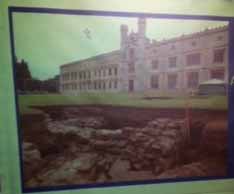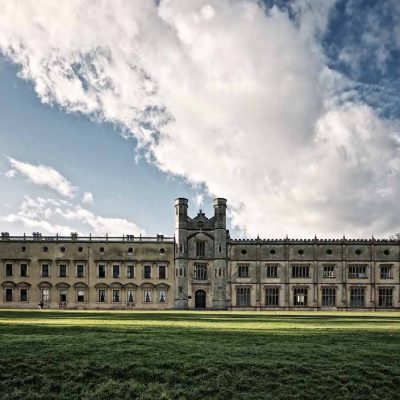

Excavations at Ashton Court
Archeoscan carried out excavation at the back of the Mansion House at Ashton Court on the lawn. In the summer of 2018, parch marks on the lawn had shown up quite a few buildings or drainage. A geophysical survey was carried out using resistivity.
Documented is a 13-14th Century walled building with a gatehouse, together with a south wing. A 1730 drawing shows this building. In 1740 a structure was added. A 1791 an engraving by J. Collinson shows a large wing. By 1802 a plan shows a projection at an angle. Anton Bantock drew the stables as a wing near the gatehouse.
The 2018 excavation at Ashton Court: Trench 1 had a significant masonry and a wall 1.2m thick, with a cobbled floor. A drain went through it. There was good quality flooring in the cellars. Trench 3 had an E-W wall and level floor which must be a cellared structure. However, the walls do not fit with the plan. Trench 2 had no masonry structures. How to explain it? Were the lower stables demolished in 1762 and aligned with the building before constructing the upper stables, which are off-kilter to the house?
Finds include a gold coloured and ruby hat pin (Victorian); antler, pottery, 17th Century clay pipe, a bottle neck; 16-17th Century buckle; Bristol pottery and a Tudor key.
Community involvement: There were lots of volunteers taking part in the dig, including the Young Archaeologists’ Club (Bristol and Bath). 360 school children visited the site.
Archeoscan will return in 2020 to explore more of the parch marks and expand the entire excavation area.
Excavation at Sherborne, Glos: This was undertaken to find the lost church. In the village can be seen the Romanesque arches in two of the cottages – were they taken from a church? They came from an orchard. Geophysical survey was carried out at Stone’s Farm. In 2013 nine trenches were laid out and they found a Roman corn drier, ‘T’ shaped. They found revetted walls and Saxon, Medieval and Victorian pottery, together with Roman painted wall plaster and a Roman spindle whorl.
In 2019 another corn drier was found in Trenches 4 and 5. It was built up against a wall. It is different in that it had painted plaster, tesserae and box flue tile. In Trench 7 was a wall with mortar and stone in layers East-West. Could this possibly be the church? Find include a buckle, Roman ring, bracelet, coins from 4th Century Roman period, plus flint and metal objects. The church has not been found yet and Archeoscan will return in 2020.
Slimbridge, Glos: thousands of coins were found and Archeoscan did geophysical survey which revealed buildings and a stock enclosure.
Guiting Power, Glos: a DMV has been found here and the remains of a Roman villa. Following parch marks a geophysical survey was carried out which revealed enclosures and stone buildings.
At Old Sodbury, Glos, geophysical survey was carried out on a field with ridge and furrow. Trackways and stock enclosures were revealed.
Archeoscan will return to Ashton Court 21 June – 25 July 2020.


Archeoscan’s excavation 2019 The lawn at the rear of Ashton Court
(image Wikipedia)
